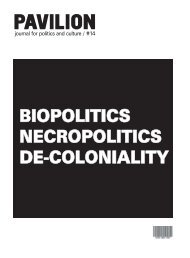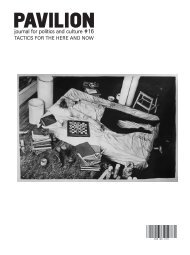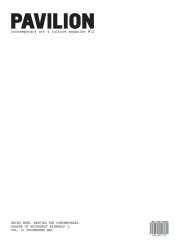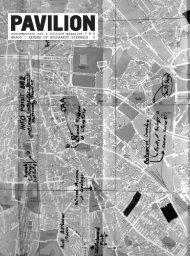PAVILION
PAVILION
PAVILION
- No tags were found...
You also want an ePaper? Increase the reach of your titles
YUMPU automatically turns print PDFs into web optimized ePapers that Google loves.
Notes:<br />
1. The German word Handlung will be kept -<br />
and its plural form Handlungen - in italic for the<br />
whole text, thus highlighting its different layers<br />
as well as its haziness. It is one of the most difficult<br />
and yet easiest words to translate:<br />
Action, activity, agency and participation, but<br />
progression, act, plot or story would also be<br />
perfect translations, but all of them are limited<br />
to one - and only one - specific meaning and<br />
therefore unable to recall the different layers<br />
that cannot be blanked, because they are permanently<br />
present. The significations of<br />
Handlung that go more in the direction of<br />
action and activity can be explained in separation<br />
from a more passive and unintended<br />
behaviour as something that is happening<br />
active and deliberately and is focused on<br />
organizing reality. Whereas the term agency<br />
has an even heavier connotation of a thing or<br />
a person to produce a particular result and<br />
could be described as form of existence, which<br />
expresses the terms political implication. On<br />
the other hand side (plot, story, etc.), Handlung<br />
has meanings close to fiction and narration;<br />
respectively they appear as something happened<br />
and something that is reported afterwards.<br />
2. The definition of ‘thing’ is based on Bruno<br />
Latour’s ideas in his essay “From Realpolitik to<br />
Dingpolitik” (cf. 196), where he advocates for<br />
an “object-oriented democracy”: “For too long,<br />
objects have been portrayed as matters-offact.<br />
This is unfair to them, unfair to science,<br />
unfair to objectivity, unfair to experience. They<br />
are much more interesting, variegated, uncertain,<br />
complicated, far reaching, heterogeneous,<br />
risky, historical, local, material and networky<br />
than the pathetic version offered or too<br />
long by philosophers. Rocks are not simply<br />
there to kicked at, desks to thumped at. 'Facts<br />
are facts are facts'? Yes, but they are also a lot<br />
of other things in addition.“<br />
3. For the German edition of The Human<br />
Condition, Hannah Arendt translated „action“<br />
as either Handeln or Handlung.<br />
4. Hanna Arendt: The Human Condition,<br />
Chicago 1958, p. 7.<br />
5. Ibid., p. 7.<br />
[12]<br />
6. Chantal Mouffe: On the Political, London<br />
and New York 2005; The Return of the<br />
Political, London 2006; The Democratic<br />
Paradox, London 2000. See also her essay<br />
Agonistic Democracy and Radical Politics in<br />
this volume (cf. 248)<br />
7. If I talk about “artistic projects” here, I understand<br />
this in the broadest sense, which<br />
includes all the other aspects and projects that<br />
are taking place within this biennale and is<br />
thus highlighting the interdisciplinary<br />
approach.<br />
8. It would go too far, if we would consider<br />
Blumenberg’s thoughts in extenso, but his<br />
short text “Prospect for a Theory of<br />
Nonceptuality” (in: Hans Blumenberg:<br />
Shipwreck with Spectator, Cambridge 1996.)<br />
gives a good idea about how a feedback<br />
between narrative structures and world good<br />
function.<br />
9. Speaking with Jacques Rancière, these are<br />
the moments in which politics happens.<br />
Rancière speaks about ‘la part de sans-part’,<br />
which becomes visible in those acts of politics,<br />
which are in fact a new “distribution of the sensible”,<br />
a new order of different regimes. Cf.:<br />
Jacques Rancière: La Mésentente. Politique et<br />
Philosophie, Paris 1995; The Politics of<br />
Aesthetics: The Distribution of the Sensible,<br />
London 2004. See also Maria Muhle’s essay<br />
“Aesthetic realism, fictional documents and<br />
subjectivation. Alexander Medwedkin. The<br />
Medwedkin Groups. Chris Marker” in this volume<br />
(cf. 151).<br />
10. Cf.: Bruno Latour: Reassembling the<br />
Social: An Introduction to Actor-Network-<br />
Theory, Oxford 2005.<br />
11. Cf.: Hayden White: The Content of the<br />
Form: Narrative Discourse and Historical<br />
Representation, Baltimore 1987; Metahistory:<br />
The Historical Imagination in Nineteenth-<br />
Century Europe, Baltimore 1973.<br />
12. Hayden White: The Value of Narrativity in<br />
the Representation of Reality, in: Critical<br />
Inquiry, Vol. 7, No. 1, On Narrative, (Autumn,<br />
1980), p. 5-27.<br />
13. “Handlungsraum” is again a very powerful<br />
German word to describe spatial conditions of<br />
actions, because it is used as a vocabulary of<br />
narrative theory and theatre as well as to<br />
determine the political area in which action is<br />
possible.<br />
14. For a more detailed analysis of this relation<br />
see Ludger Schwarte’s text Performative<br />
Architecture: Setting a Stage for Political<br />
Action in this volume (cf. 172)<br />
15. Arendt, p. 200.<br />
16. Boris Groys talks about a double erasure<br />
in Eastern Europe: The first one with the<br />
beginning of socialist and communist regimes<br />
and more recently the introduction of the capitalist<br />
economic/cultural system.<br />
17. I do not want to spend much time with historical<br />
facts and just highlight one of the major<br />
differences to other European cities in the middle<br />
ages, that is the absence of a city wall.<br />
Leaving aside all military consequences here,<br />
this uncommon structure has still some impact<br />
into recent days. Through the nonexistence of<br />
a city wall, it is impossible to constitute the borders<br />
of the city and thus having a relatively diffuse<br />
notion of its spatial existence.<br />
18. It has to be mentioned that this conception<br />
is anything but new. Its roots can be found in<br />
modernity, if we think about Le Corbusiers<br />
“unité d’habitation” and later on (but still earlier<br />
than Ceaușescu) in projects of Team Ten<br />
members.<br />
19. Srdjan Jovanović Weiss describes those<br />
structures and transformation as‚ turbo-architecture’,<br />
according to the popular music genre<br />
‚turbo-folk’, a very fast and eclectic mix of traditional<br />
East European folk music, Western<br />
pop music as well as techno and rock.<br />
[13]








